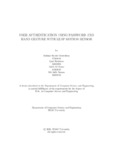| dc.contributor.advisor | Uddin, Jia | |
| dc.contributor.author | Chowdhury, Mishkat Haider | |
| dc.contributor.author | Shadman, Qazi | |
| dc.contributor.author | Al Hasan, Sakib | |
| dc.contributor.author | Hassan, Md Adib | |
| dc.date.accessioned | 2020-11-28T03:59:59Z | |
| dc.date.available | 2020-11-28T03:59:59Z | |
| dc.date.issued | 2020 | |
| dc.identifier.other | ID 17201032 | |
| dc.identifier.other | ID 16101194 | |
| dc.identifier.other | ID 15301035 | |
| dc.identifier.other | ID 16101324 | |
| dc.identifier.uri | http://hdl.handle.net/10361/14089 | |
| dc.description | This thesis is submitted in partial fulfillment of the requirements for the degree of Bachelor of Science in Computer Science, 2020. | en_US |
| dc.description | Cataloged from PDF version of thesis. | |
| dc.description | Includes bibliographical references (pages 41-42). | |
| dc.description.abstract | User Authentication is becoming a significant factor in the field of modern technology.
It is a process that permits a device to confirm the recognition of somebody
who interfaces with a system asset. In the world of AI, machine learning is currently
one of the leading research fields which is looking into practical implementation. In
this report, we propose a method where the user will enter the given password while
leap motion sensor will compare the behavioural data of the user with an existing
dataset. Leap motion controller is a sensor or gadget which can recognize 3D
movement of hands, fingers and finger like articles with no contact. Moreover we
will be discussing the benefits of using behavioural biometrics instead of physiological
biometrics for security, and how behavioural biometrics can solve the faults of
physiological biometrics. In addition, we will be discussing the benefits of using
leap motion sensor along with password authentication to properly identify an user
and how it can improve security. For our project, we chose to use Dynamic Time
Warping and Naive Bayes Classifier algorithm. DTW algorithm will be useful by
comparing two frames which differ in time or velocity when one user have multiple
behavioral entries before identifying user as valid or invalid. Naive Bayes will classify
a user as valid or invalid through allowing classifiers to learn user data through
features. The proposed system has about 91% accuracy which rises to 93% in the
best-case scenario. We believe that because Leap Motion is comparatively low cost
at the exchange of an extra layer of security it provides, the proposed system can
ensure a secure and efficient environment for user authentication. | en_US |
| dc.description.statementofresponsibility | Mishkat Haider Chowdhury | |
| dc.description.statementofresponsibility | Qazi Shadman | |
| dc.description.statementofresponsibility | Sakib Al Hasan | |
| dc.description.statementofresponsibility | Md Adib Hassan | |
| dc.format.extent | 42 pages | |
| dc.language.iso | en | en_US |
| dc.publisher | Brac University | en_US |
| dc.rights | Brac University theses are protected by copyright. They may be viewed from this source for any purpose, but reproduction or distribution in any format is prohibited without written permission. | |
| dc.subject | DTW(Dynamic Time Warping) | en_US |
| dc.subject | Naive bayes classifier | en_US |
| dc.subject | Leap motion sensor | en_US |
| dc.subject | Password authentication | en_US |
| dc.subject | Physiological biometrics | en_US |
| dc.subject | Behavioral biometrics | en_US |
| dc.subject | FRR(False Rejection Rate) | en_US |
| dc.subject | FAR(False Acceptance Rate) | en_US |
| dc.title | User authentication using passowrd and hand gesture with leap motion sensor | en_US |
| dc.type | Thesis | en_US |
| dc.description.degree | B. Computer Science | |

